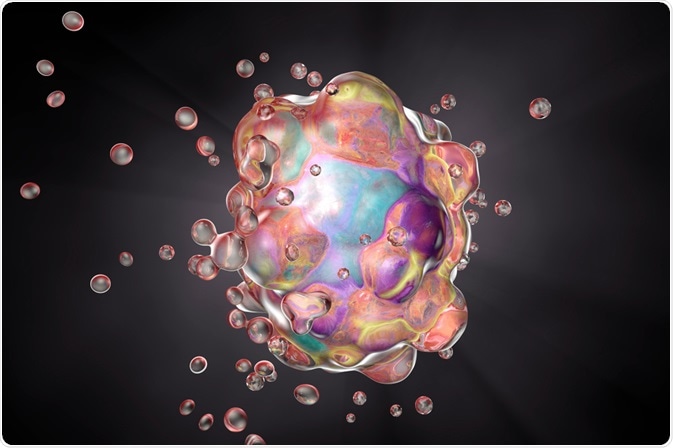Detection of apoptosis

Image Credit: Kateryna Kon/Shutterstock.com
Terminal deoxynucleotidyl transferase dUTP nick end labeling, also known as TUNEL staining or the TUNEL assay, is a robust technique for the detection of apoptosis.
This kind of cell death is known to be characterized by nuclear DNA fragmentation to nucleases. TUNEL staining was developed to detect apoptosis by identifying these DNA breaks.
Apoptosis is a genetically regulated type of cell death that is vital to numerous biological processes, from embryogenesis to aging, and it is even implicated in many diseases.
Apoptosis is targeted in several treatments for disease, such as non-steroidal anti-inflammatories and anticancer treatments. Research continues to develop new therapies that are aimed at modifying apoptosis to treat a number of illnesses.
For this reason, TUNEL staining has become an essential tool as it allows scientists to gain a deeper understanding of the role of apoptosis in disease, helping them to develop new apoptosis-based treatments.
While morphological assessment has emerged as the standard method for the identification and quantification of apoptosis, TUNEL staining remains a trusted and reliable alternative that has many benefits.
For example, the TUNEL method can be faster than alternatives, and can sometimes be more sensitive, depending on the protocol used. In addition, because TUNEL staining investigates DNA breaks that occur early on in apoptosis, it can detect apoptotic cells prior to when morphological assessment could identify them.
The basics of TUNEL staining
The technique of TUNEL staining exploits the activity of the terminal deoxynucleotide transferase (TdT) enzyme. To conduct the protocol from start to finish it takes around one to two hours, however, this does not include the time needed for tissue preparation or cell culture.
The process sees TdT add deoxynucleotides to the 3’-hydroxyl terminus of DNA fragments that break off at the final stage of apoptosis. Certain cells of the immune system express TdT, which is active during V(D)J recombination.
TUNEL staining uses a fluorescent or chemical label and attaches to the nucleotides that have been added to the 3’-hydroxyl terminus of DNA breaks by TdT. Studies have concluded that the TUNEL method is more sensitive than the alternative in situ nick translation assay (ISNT) because it generates a greater label intensity of apoptotic cells.
Types of TUNEL staining
Light microscopy is most often used to analyze the data generated by TUNEL staining, although flow cytometry can also be used to analyze fluorescent TUNEL staining.
There are three main techniques used in TUNEL staining techniques, the first is conjugating a nucleotide to a fluorescent dye, most commonly this is FITC. The second method is where biotin-tagged nucleotides are bound by streptavidin-HRP and detected with a form of a chromogenic HRP substrate, usually DAB, which converts the bound nucleotides to a brown color so they are easily visible.
The final technique sees digoxygenin-, bromo-, digoxygenin-, or FITC-tagged nucleotides binding with specific antibodies, which either a fluorescent dye or an enzyme has tagged for chromogenic detection.
Applications of TUNEL staining
Discovering more about how apoptosis works, have become vital to the research and development of new clinical approaches for numerous diseases and disorders due to its underlying role in illness.
Conditions including neurodegenerative diseases, such as Parkinson’s disease, Alzheimer’s disease, amyotrophic lateral sclerosis, ischaemic injury after stroke, reperfusion, and myocardial infarction, as well as autoimmune diseases such as hepatitis, graft versus host disease, and AIDS all present increased levels of apoptosis that are considered a feature of the illness. In addition, decreased apoptosis has been found to be characteristic of autoimmune disorders such as systemic lupus erythematosus, and some viral infections.
TUNEL staining has been fundamental to increasing the knowledge around apoptosis in these illnesses. For example, it has been key to research that has set out to explore the nature of apoptosis in Alzheimer’s disease.
TUNEL staining helped scientists to confirm that the primary neuronal cell loss and in the glial response that is characteristic of AD is related to apoptosis.
TUNEL staining has been used as a reliable method of apoptosis identification in numerous studies of AD, allowing researchers to efficiently compare the brains of healthy populations against those with AD in order to elucidate the significant differences in apoptosis behavior between the two.
Similarly, TUNEL staining has proven fundamental to the advancement of our understanding of how apoptosis manifests in Parkinson’s disease (PD). It has been used in studies that have uncovered that apoptosis is likely a vital mechanism of cell death in PD, highlighting that it is a major underlying cause of nigral neuronal death, which is characteristic of PD.
Further to this, TUNEL staining has uncovered the influential activity of apoptosis in infections such as rabies and herpes simplex, as well as being fundamental in demonstrating the therapeutic value of new exploratory treatments.
TUNEL staining has played a major role in studies looking into the relationship between apoptosis and all the related diseases highlighted above. It is likely to continue to be used to explore pathology and to assist in innovating more effective treatments that target abnormal apoptosis.
In the future, we can expect to see new treatment options emerge for apoptosis-related illnesses as a result of research that has relied on the TUNEL staining method.
Sources
· Kyrylkova, K., Kyryachenko, S., Leid, M. and Kioussi, C. (2012). Detection of Apoptosis by TUNEL Assay. Methods in Molecular Biology, pp.41-47. https://link.springer.com/protocol/10.1007%2F978-1-61779-860-3_5
· Mochizuki, H., Goto, K., Mori, H. and Mizuno, Y. (1996). Histochemical detection of apoptosis in Parkinson's disease. Journal of the Neurological Sciences, 137(2), pp.120-123. https://www.sciencedirect.com/science/article/abs/pii/0022510X9500336Z
· Renehan, A. (2001). What is apoptosis, and why is it important?. BMJ, 322(7301), pp.1536-1538. https://www.ncbi.nlm.nih.gov/pmc/articles/PMC1120576/
· Perng, G. (2000). Virus-Induced Neuronal Apoptosis Blocked by the Herpes Simplex Virus latency-associated Transcript. Science, 287(5457), pp.1500-1503. https://science.sciencemag.org/content/287/5457/1500
· Smale, G., Nichols, N., Brady, D., Finch, C. and Horton, W. (1995). Evidence for Apoptotic Cell Death in Alzheimer's Disease. Experimental Neurology, 133(2), pp.225-230. https://www.sciencedirect.com/science/article/abs/pii/S0014488685710254
Further Reading